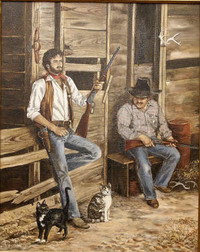Login form
Cowboys
 Picture spending your days riding a horse in the great outdoors. During daylight, you tend herds of cattle on vast stretches of open land. At night, you cook your meals over a campfire and sleep under the stars. Such was the life of an American cowboy.
Picture spending your days riding a horse in the great outdoors. During daylight, you tend herds of cattle on vast stretches of open land. At night, you cook your meals over a campfire and sleep under the stars. Such was the life of an American cowboy.
Life as a cowboy may sound exciting and fun. But cowboys spent long hours doing hard, often dangerous, work. It could also be very lonely out on the range, even downright boring!
WHAT IS A COWBOY?
A cowboy is a ranch worker who rides on horseback to herd cows. Cowboys won fame on the Western frontier for their endurance and independent way of life. The first cowboys worked on Spanish ranches in California in the 1600s.
THE AGE OF COWBOYSThe best-known cowboy period began after the American Civil War ended in 1865. It lasted through the 1890s. At that time, millions of wild cows roamed the unfenced Western plains. As the American population grew, more and more people wanted beef to eat.
When the war ended, thousands of jobless soldiers needed work. Cattle ranchers saw this as a chance to make money. They hired men to round up the wild cows for them.
The wild cows were known as Texas longhorns, because large numbers of these long-horned animals roamed the Texas plains. Texas longhorns were descended from Spanish cattle that had escaped and multiplied on the range.
WHAT DID COWBOYS DO?
A cowboy’s main job was to herd cattle to the range to graze. Cowboys also had to protect their herds from outlaws, called rustlers, who wanted to steal cattle. For this reason, many cowboys carried pistols.
A cowboy’s greatest fear was not of outlaws, but of stampedes. A stampede is a charge by a herd of cows in a panic. Anyone in the path of a stampede can get trampled.
Twice a year, in the spring and fall, the roundup took place. During a roundup, all the cattle were brought together so newborn calves could be identified. In the days of the open range, cattle belonging to different owners might get mixed together. For this reason, cowboys burned special marks on the calves with hot irons. These marks, called brands, showed who owned the animals.
An important event in the life of a cowboy was the trail drive. During a drive, cowboys herded the cows to towns that had railroad stations. A trail drive might cover hundreds of miles and last several months. Once the cowboys arrived in town with their herd, the cows were shipped to meatpacking plants in big cities.
A COWBOY’S EQUIPMENT
Cowboys wore clothes that fit their job. Their famous “ten-gallon” hats had big brims to give them shade. They kept kerchiefs, or bandannas, around their necks to shield their mouths from dust.
Cowboys wore tough cotton jeans, called denim. Over their pants they wore leather flaps, or leggings, called chaps. Denim and chaps let cowboys ride through thorny brush. High boots protected their ankles. The long heels of their boots helped keep their feet in the stirrups.
All cowboys carried a rope called a lariat, or lasso. They tied the lariat to their saddles. A cowboy could put a loop in his lariat, whirl it over his head, and catch a cow that had strayed.
COWBOYS TODAY
There are still cowboys working today in parts of the American West. But the old-time cowboy way of life mostly disappeared after fences were built across the Western plains.
Modern cowboys still work hard, wear chaps and boots, and sport large cowboy hats. They must be expert horse riders and know how to use their ropes. But they use many modern machines, including trucks for moving cattle to market and chain saws to cut fence posts.
WHY ARE COWBOYS REMEMBERED?
The cowboys’ independent, hard-working life made them seem like heroes to many. American writers such as Zane Grey and Louis L’Amour wrote novels about courageous cowboys. Countless movies and television shows portray cowboys. Today, in many countries, cowboys are seen as a symbol of America.
Source: Microsoft ® Encarta

